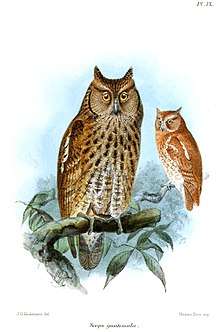Middle American screech owl
The Middle American screech owl (Megascops guatemalae), also known as the Guatemalan screech owl, is a species of owl in the family Strigidae and is usually found in forests and dense second growth. The taxonomy of this species and the vermiculated screech owl can be confusing. When split, the name vermiculated screech owl (M. vermiculatus) is used for the population from eastern Nicaragua to Panama, and this species is found from northern Mexico to Nicaragua. When conspecific, the English name vermiculated screech owl is used, but M. guatemalae is used for the scientific name since it is older.[2] The "guatemalae" larger conspecific group usually includes the foothill screech owl, M. roraimae and the Choco screech owl, M. centralis.
| Middle American screech owl | |
|---|---|
 | |
| Scientific classification | |
| Kingdom: | Animalia |
| Phylum: | Chordata |
| Class: | Aves |
| Order: | Strigiformes |
| Family: | Strigidae |
| Genus: | Megascops |
| Species: | M. guatemalae |
| Binomial name | |
| Megascops guatemalae (Sharpe, 1875) | |
| Synonyms | |
|
Otus guatemalae (Sharpe, 1875) | |
With a length of 20 to 23 centimetres (7.9 to 9.1 in), it is a smaller than most other screech-owls. Unlike other owls of the same genus, it has feathered feet. It is dimorphic, with one morph overall grayish-brown and the other overall rufous. The tail is relatively long for an owl, the underside has conspicuous longitudinal stripes and some horizontal stripes. Its face is surrounded by a dark feather edge and it has relatively short ear tufts. The eyes are yellow. The beak is pale olive-greenish in color.
Subspecies
Currently, the Middle American screech owl has five recognized subspecies:[3]
- M. g. cassini (Ridgway, 1878)
- M. g. dacrysistactus (R. T. Moore & J. L. Peters, 1939)
- M. g. fuscus (R. T. Moore & J. L. Peters, 1939)
- M. g. guatemalae (Sharpe, 1875)
- M. g. hastatus Ridgway, 1887
References
- BirdLife International (2016). "Megascops guatemalae". The IUCN Red List of Threatened Species. IUCN. 2016: e.T61767847A95179450. doi:10.2305/IUCN.UK.2016-3.RLTS.T61767847A95179450.en.
- Robbins, M. B. (2001) Continue to recognize a broad Otus guatemalae (namely to include O. vermiculatus, O. napensis, O roraimae) Archived 2010-06-28 at the Wayback Machine. South American Classification Committee. Accessed 25 January 2011.
- "Megascops guatemalae". Integrated Taxonomic Information System. Retrieved 2010-12-28.
- König, C., F. Weick & J.H. Becking (2008) Owls of the World. Christopher Helm, London, ISBN 978-0-7136-6548-2
